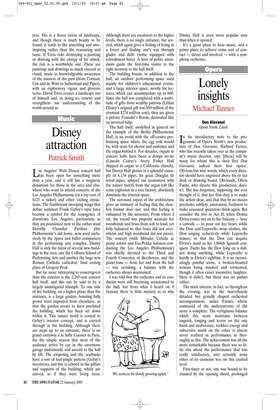Disney attraction
Patrick Smith
Los Angeles’ Walt Disney concert hall has been open for something more than a year, and it still has a magnetic dynamism for those in the area and elsewhere who want to attend concerts of the Los Angeles Philharmonic (at a top cost of $125 a ticket) and other visiting attractions. The flamboyant swooping wings that define architect Frank Gehry’s style have become a symbol for the resurgence of downtown Los Angeles, particularly as they are positioned next to the rather staid Dorothy Chandler Pavilion (the Philharmonic’s old home, now used exclusively by the opera and ballet companies) in the performing arts complex. Disney Hall is only the latest of several new buildings in the area, one the Colburn School of Performing Arts and another the huge new Roman Catholic cathedral, final resting place of Gregory Peck.
But far more interesting to concertgoers than the exterior is the 2,265-seat concert hall itself, and this can be said to be a largely unmitigated triumph. To one side of the building, on a higher plane than the entrance, is a large garden, boasting fully grown trees imported from elsewhere, so that the garden seems to have predated the building, which has been set down within it. This nature motif is central to Gehry’s interior concept, and is carried through in the building. Although there are steps up to an entrance, there is no grand entryway à la Salle Garnier in Paris, for the simple reason that most of the audience arrive by car in the cavernous garage underneath, and ascend to the hall by lift. The carpeting and the seatbacks have a sort of leaf-jungle pattern (Gehry’s invention), and this is echoed in the pillars and supports of the building, which are curved, as if they were living trees. Although there are escalators to the higher levels, there is no single entrance, but several, which again gives a feeling of being in a forest and finding one’s way through glades and dells (some equipped with refreshment bars). A host of polite attendants guide the first-time visitor to the right doorway to the hall itself.
The building boasts, in addition to the hall, an outdoor performing space used mainly for children’s educational events, and a large interior space, mostly for lectures, which can accommodate up to 600. Since the hall was completed with a multitude of gifts from wealthy patrons (Lillian Disney’s original gift was $50 million of the eventual $274 million cost), they are given a private Founder’s Room, decorated like an inverted tulip.
The hall itself, modelled in general on the example of the Berlin Philharmonic Hall, is an ovoid with the off-centre performing space where the egg yolk would be, with seats for chorus and audience and the organ behind it. For decades, organs in concert halls have been a design no-no (Lincoln Center’s Avery Fisher Hall shipped its organ to a California church), but Disney Hall glories in a splendid example of 6,134 pipes. Its great Douglas fir wood pipes, splayed out (consistent with the nature motif) from the organ loft like some explosion in a tree factory, absolutely dominate the interior space.
The surround aspect of the architecture gives an intimacy of feeling that the shoebox format does not, and this feeling is enhanced by the acoustics. From where I sat, the sound was pinpoint accurate for woodwinds and brass from soft to loud, yet fully balanced so that brass did not overwhelm and high woodwind did not pierce. The concert (with Mitsuko Uchida as piano soloist and Esa-Pekka Salonen conducting the Los Angeles Philharmonic) was chiefly devoted to the Third and Fourth Concertos of Beethoven, and the piano tone — from her and from the hall — was ravishing, a balance with the orchestra always maintained.
I was told that the orchestra and its conductor were still becoming accustomed to the hall, but from what I heard on 8 January there is little mystery as to why Disney Hall is even more popular now than when it opened.
It’s a great place to hear music, and a prime place to achieve some sort of contact — direct and involved — with a symphony orchestra.













































 Previous page
Previous page